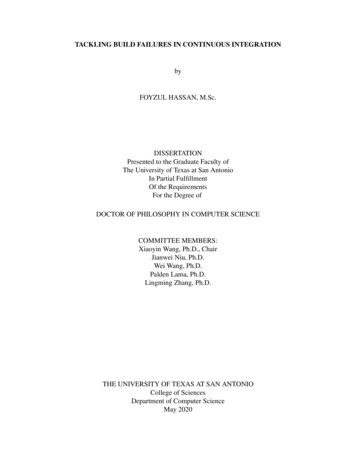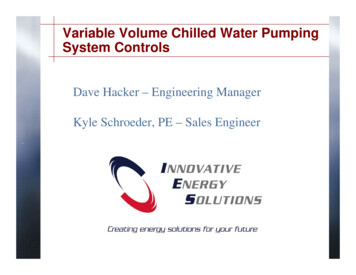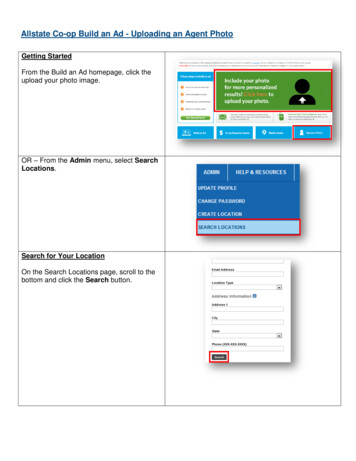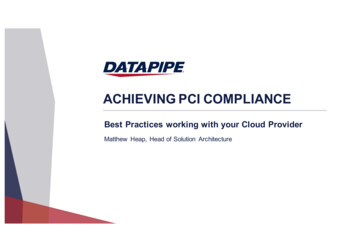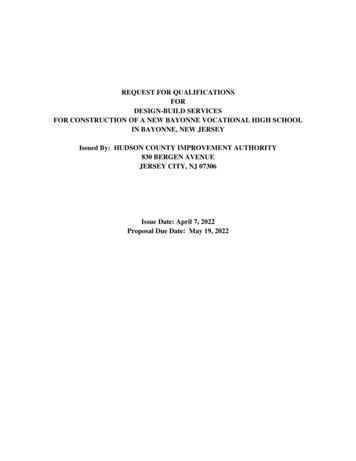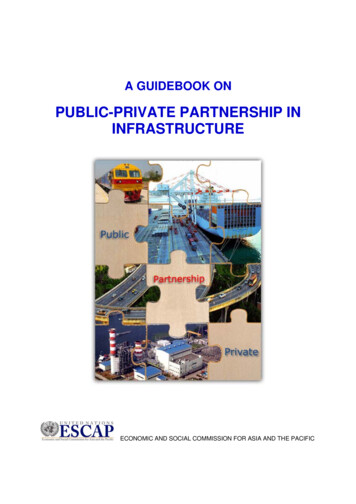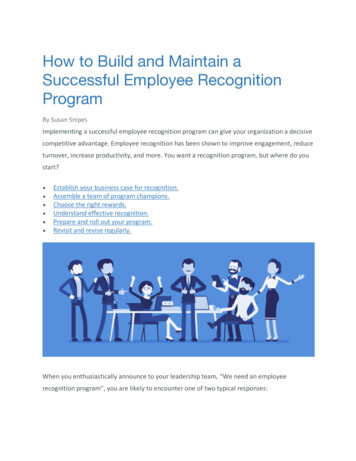
Transcription
How to Build and Maintain aSuccessful Employee RecognitionProgramBy Susan SnipesImplementing a successful employee recognition program can give your organization a decisivecompetitive advantage. Employee recognition has been shown to improve engagement, reduceturnover, increase productivity, and more. You want a recognition program, but where do youstart? Establish your business case for recognition.Assemble a team of program champions.Choose the right rewards.Understand effective recognition.Prepare and roll out your program.Revisit and revise regularly.When you enthusiastically announce to your leadership team, “We need an employeerecognition program”, you are likely to encounter one of two typical responses:
The business outcomes response. In this scenario, the leadership team acknowledges that arecognition program would be “nice”, but they want to see a cost-benefits analysis beforeallocating resources to such an undertaking. They want to know how the program will furtherthe company’s short and long-term goals and overall mission.This means more work for you, and you might wonder how you can prove that a formalrecognition program will work for your organization. This is actually a great opportunity to flexyour business acumen muscles. By leveraging the right resources, you can show that you are atrue partner who understands what the organization needs. And all the data you need tosupport your case is readily available.if you know where to look.The gut-feel response. Not all leaders are driven by data. In this scenario, the leadership teamimmediately says, “Yes, agreed! Go ahead and put one together for us” with no questionsasked. Someone from the leadership team may have even approached you first about creatinga program.The executive who assigned you this project may or may not have any clear expectation of whatthe program should look like, and you may get sent back to the drawing board repeatedly. Andthe high level of enthusiasm and energy around the project may fizzle out if quick progress isnot seen. Lacking clear direction can be extremely frustrating and dejecting, and it can end uptaking you more time than if you had done a full analysis and presented options upfront.Either type of response requires you dig deep and really evaluate why your organization needsa recognition program, what types of recognition make the most sense, and how to successfullyimplement the program.
Establish your business case for recognition.One of the best ways to establish a business case is to tie your expected project outcomes todesired business outcomes. Ask yourself: What problems might anemployee recognitionprogram solve, and how does solving those problems further the company’s businessobjectives? How do I show that the benefits outweigh the costs?A great employee recognition program generates employee engagement and is likely to solveproblems like high turnover, low morale, and performance plateaus.Turn around turnover.
When employees leave, the cost of replacing them can noticeably damage a business’s bottomline. You must consider not only the recruiting costs but the cost to train and recover lostknowledge and efficiency. Then there are the hidden costs like the negative impact on moralewhen an employee leaves.Depending on the industry and position needing to be filled, turnover can cost anywherefrom 16% to 213% of an employees’ annual salary. Specific costs associated with replacing anemployee include an increased unemployment tax rate, writing and posting a job description,interviewing candidates, paying referral bonuses, increasing the workload of existing employeeswhile a position is open, and training new hires.There are several tools and resources available to help you calculate the true cost of employeeturnover for your organization.One proven way to retain valued employees and reduce costs is to recognize employees fortheir contributions. Research by Josh Bersin showed that the companies that scored the highestin building a recognition-rich culture had 31% less voluntary turnover than those with lowerrecognition scores. This is likely because employees who don’t feel recognized are twice aslikely to quit within a year. And 83% of respondents in a study featured in PsychologyToday stated that being recognized for their contributions was more fulfilling than monetaryrewards alone.
Consider engagement.Recognition effectively solves these common business problems because it is directly linked toemployee engagement. Engagement (inclusive of but not the same as “happiness”) is theincreased participation and enthusiasm level of an employee towards work. An engagedemployee takes positive action to further the company’s goals and reputation.Unmotivated, detached employees show less dedication to their work than incentivized,engaged individuals. When employees are unhappy at work, theirproductivity suffers due toincreased absenteeism, disorganized workspaces, conflicts with coworkers and insubordination.Key competencies required for employees to succeed like creativity and self-directedness alsosuffer. This results in workers getting caught in a low morale loop due to poor performance andthe resulting lack of recognition.
Research supports the position that your new employee recognition program will increaseengagement. 58% of professionals feel that leaders could do more to improve engagementthrough giving recognition. And Willis Towers Watson found that recognition increasesemployee engagement up to 60%.With the strong link between productivity and engagement, it is clear that employees requirerecognition to perform their best. By providing your leadership team withestimated costs ofmorale-related downtime, you can make a strong business case for recognition.Compare benefits with costs.We’ve established the potential benefits of recognition programs, but how much does a goodrecognition program cost to administer? It may surprise you to learn that recognition programsdo not have to be expensive to be effective. 81% of companies that include a recognitionprogram in their budgets spend less than 1% of their payroll budgets on those programs.Many companies, particularly smaller ones, can use existing resources that are already in thebudget for employee recognition. Larger companies may need to take a closer look at budgetflexibility, since having more employees could warrant a dedicated Employee EngagementSpecialist.To reduce the labor cost to program quality ratio, affordable employee recognition tools can beleveraged. These tools typically charge a small per-employee fee, include automatedfunctionality, and use a built-in framework to increase the likelihood of program success.You must also account for the costs of any awards or prizes with monetary value. Such awardscan be augmented with other non-monetary types of recognition to maximize impact withoutmaximizing expenses.
Assemble a team of program champions.You’ve received leadership buy-in from the financial and cultural viewpoint, and you are readyto start putting together the actual program. Before implementation comes planning, and, inorder to plan effectively, you will need help. Seek out several champions to help conceptualize,promote, communicate, implement and reinforce your recognition program. These championsshould ideally: be interested in participating (no mandatory fun, please)be in front-line leadership positionsunderstand how the program benefits employees and the businessunderstand what motivates people on their teambe willing and able to make the program a prioritybe exemplary employees (no performance or conduct issues)
Program champions with the above characteristics will be closest to the heartbeat of theorganization and will provide the most helpful insights. They will also be in the best position toensure program success.Choose the right rewards.Align rewards with company culture and core values.Every company has its own unique vibe based on its leadership, employee population, andindustry (among other things). This “personality” is one component of a company’s culture.
Many companies adopt core values to explain what individuals need to believe, do, or be toenjoy success.Rewards and recognition should support these values to promote and reinforce the rightcompany outcomes. If your company values individual empowerment, you might considerletting employees to select their own rewards from a pre-approved list of options. If yourcompany values fairness, then the rewards might need to be more standardized, equitable andclosely monitored to avoid too many payouts to the same people.Offer a variety of rewards that cater to individualpreference.Different people enjoy different types of rewards. A points system where employees rack uprecognition bucks to spend on a variety of prizes is one great way to accommodate personalpreference. Prizes can include cash, gift cards, items, PTO, or all-expense-paid vacations. Youcan even let employees save up their bucks and combine prizes for the ultimate reward. Ofcourse any extrinsic rewards should be accompanied by intrinsic rewards like public praise andpersonalized thank you notes.Don't forget to discuss rewards around work anniversaries, birthdays, and other importantmoments.
Understand effective recognition.Appreciate thoughtfully.Before starting any employee recognition program, make sure that your team understands howto thoughtfully appreciate one another. Recognition should be specific, timely, frequent, visible,values-based, and inclusive. Remember that any recognition isn’t measured at your own mouthbut at the ears of the recipient. That means you’ll want to regularly appreciate others as soonas possible, tying praise to purpose.It may take some time, but you’ll see the “Great job in that meeting!” turn into “Wow, the casestudy research you shared during today’s meeting made a huge difference in convincing the ourcustomer to adopt our solution. We’re so glad you’re a part of the team!“ Of course, you’llwant to share this kind of praise right after the action takes place instead of hearing about it atnext quarter’s review.Use the Situation, Behavior, Impact model.
Originally developed by the Center for Creative Leadership, the Situation, Behavior, Impact is aframework to give feedback in a way that strengthens trust and foster understanding betweenparties. It’s often referenced in advice for giving constructive feedback and can also be used toshare effective recognition.Allow for manager and peer recognition.There are many competencies and behaviors that you may want to reward that go unnoticedby some. A payroll specialist who always goes the extra mile to help managers get correctemployee time in before payroll is run might get high praise from her internal customers. Thesame accomplishment might be ignored or underappreciated by her boss or department head.By allowing positive peer feedback, you increase the likelihood that everyone will getrecognized for their meaningful contributions.Have a plan to avoid incorrect or under recognition.Identify recognition best practices for rewarding team members. Do not focus on individualpeople when designing the reward system. Instead, focus on the accomplishments andbehaviors you want to recognize and share guidelines on how to give great recognition.
The company’s main focus may shift over time based on their current pain points. For example,collaboration might be a main focus one month. In this case, emphasizing your teamworkbonus might be most appropriate. Another month, creativity could be suffering, so promotingyour innovation bonus would make more sense.It is also important to ensure that the rewards are going to the right people. Even if they aregoing to the right people, certain patterns of reward issuance may look suspicious or unfair toothers. Since perception is reality, you want to design your program to avoid even perceivedfavoritism. Some recognition programs will automatically flag suspicious behavior.Keep constructive or critical feedback separate.The employee recognition program is strictly an opportunity to reward and recognize goodresults and actions. It is not appropriate to use a recognition platform to point out people’sshortcomings and opportunities for improvement. Those constructive conversations are alsocritical to an employee's success and should definitely occur, just not when delivering praiseand rewards.The mixed message combining praise with criticism sends (You’re great at X, but we don’t reallycare that much because you’re also bad at Y) defeats the purpose of recognition and can tankyour program.For more on recognition best practices, take a look at The Guide to Modern EmployeeRecognition and The Art and Science of Recognition: 5 Best Practices for Employee RecognitionPrograms.
Prepare and roll out your program.Consider all-in-one recognition platforms for easyprogram implementation and management.Complicated tracking and ongoing program maintenance isn’t for everyone. If you prefer usingone login to track and issue rewards, send and store program-related communications, surfaceemployee accomplishments, then a platform like Bonuslymay be right for you and yourorganization.“But I already have to login to our HRIS, ATS, IM, Email and about a million other systems everyday.” Perfect- Bonusly integrates with all of these types of systems. You can manage everything
from a platform you already use with either single-sign-on or with separate sign-ons to systemsthat automatically update each other. Either way, you save valuable time that can bereallocated towards making your recognition program successful.Focus on timing and delivery.Timing a delivery may decide the success or failure of your program. You need to find the bestvehicles to communicate with employees about the new recognition initiative. Different typesof workforces tend to prefer different methods of communication. For example, front lineemployees at a manufacturing plant may prefer to get important updates via SMS or usespecialized kiosks, while administrative and managerial staff at an accounting firm might preferemail. Employees at a tech startup might prefer a smartphone app or a collaboration tool likeSlack.More than one method of communication should always be used. All-hands meetings may workfor small to mid-sized organizations. And face-to-face, one-on-one time with employees iscritical regardless of the industry or position type. Managers should also communicate withtheir teams in smaller team meetings about the program and show their support for theinitiative. Since not all teams or individuals work in the same location, managers should includeremote workers via video conferencing to share program information when needed.Whatever you do, do not be afraid to “over communicate” about the program. Change isdifficult for organizations, and employees should be reminded of the program rewards andrequirements regularly. A bi-weekly reminder about the program that also highlights therewards received by those who are actively participating helps increase participation levels andoverall program awareness.In addition to frequently communicating about the program, you’ll need to announceemployees’ rewards and accomplishments. By issuing bonuses and other rewards andrecognition as soon as possible, you address accomplishments while they are most relevant.Rewarding and recognizing people promptly also maximizes the behavioral impact by givingemployees more time to associate the reward with the desired behavior.
Revisit and revise regularly.No program is perfect, and even really great programs need to be well-maintained to remaineffective. Soliciting program feedback quarterly can help you determine whether or notemployees still value the types of rewards they are receiving. Managers’ and Directors’feedback will provide further insight into whether or not the program is impacting jobperformance and business outcomes in a meaningful way.In addition to evaluating the program, you should understand which outcomes are neededmost. An annual engagement survey will help you identify the company’s primary opportunitiesfor improvement based on your company’s ever changing employee population.Once you’ve collected actionable data, make the improvements you can. For any desiredimprovements that you are unable to make, be sure to explain why (e.g. timing, cost,redundant to other initiatives, etc.).
Employee recognition is a powerful way for any organization to succeed, and using a speciallydesigned recognition program can be an extremely effective way for teams to feel valued,perform better, stay engaged, and more. We invite you to implement your own initiatives andstart building a recognition-rich organizational culture.Written by Susan SnipesBusiness Owner. Author. Purveyor of HR Business Solutions.ComplianceConsultant Extraordinaire. Mother, Wife and Schnoodle Enthusiast.
Implementing a successful employee recognition program can give your organization a decisive competitive advantage. Employee recognition has been shown to improve engagement, reduce turnover, increase productivity, and more. You want a recognition program, but where do you . It may surprise you to learn that recognition programs .

